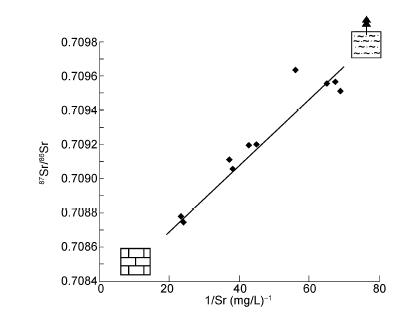
Figure The linear positive relationship between (87Sr/86Sr) and (1/Sr) for drip water.
The strontium isotopic compositions (Sr-87/Sr-86) of samples including soils, bedrock, soil waters, drip waters and their corresponding speleothems in the Qixing Cave (QXC), Guizhou Province, China, were systemically measured and analyzed. The results indicate that there are significant Sr isotopic differences among samples. The mean Sr-87/Sr-86 ratios in drip water for the samples 1(#), 4(#) and 9(#) were 0.709568, 0.709139 and 0.708761, respectively, which possibly result from different flow paths, residence times, and other hydrogeological processes in the unsaturated zone overlying QXC. Meanwhile, levels of 40.8%, 57.6% and 72.4% of Sr in drip waters for 1(#), 4(#) and 9(#), respectively, were derived from bedrock dissolution, which was calculated by the mixture model of the two end-members (soil and bedrock). There is, however, no positive correlation between the relative proportion from bedrock dissolution (delta C-13 value is 1.8aEuro degrees) and drip water delta C-13(DIC) values. The mean drip water delta C-13(DIC) value in 1(#) is the heaviest (-4.5aEuro degrees) with the lowest contribution rate of bedrock dissolution, whereas the value in 9(#) is the lightest (-9.3aEuro degrees) with the highest contribution rate of bedrock dissolution. The proportion from host rock dissolution in 4(#) is higher than that in 1(#) and lower than that in 9(#), while its mean drip water delta C-13(DIC) value (-8.6aEuro degrees) is higher than that of 9# and lower than that for 1(#). This suggests that the prior calcite precipitation (PCP) processes in the unsaturated zone overlying the cave are responsible for the delta(CDIC)-C-13 value differences between different drip waters, and not bedrock dissolution. Furthermore, this study also demonstrates that the Sr-87/Sr-86 ratios of speleothems in the 1(#) and 4(#) mainly reflect the variation in the relative proportions from the soil system (soil water) and bedrock dissolution overlying the cave. It is, therefore, feasible to use the strontium isotopic signals of speleothems as an indicator for soil chemical weathering intensity, and consequently as a monsoon proxy in the study area.
| Publication name |
CHINESE SCIENCE BULLETIN Volume: 56 Issue: 7 Pages: 670-675 Published: MAR 2011 |
| Author(s) |
Zhu XiaoLong; Wang ShiJie; Luo WeiJun |
| Corresponding author |
WANG Shijie
wangshijie@vip.skleg.cn
Chinese Acad Sci, Inst Geochem, State Key Lab Environm Geochem, Guiyang 550002, Peoples R China |